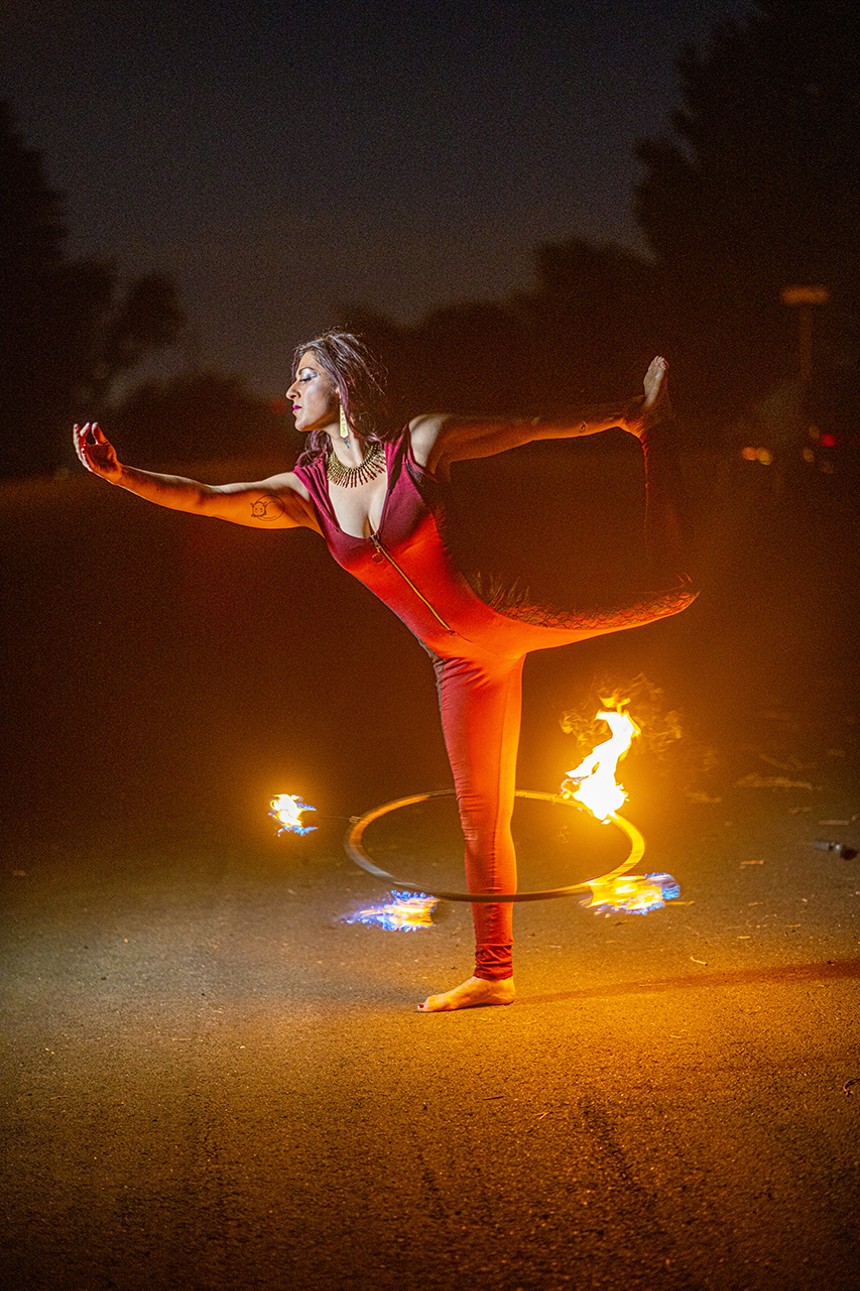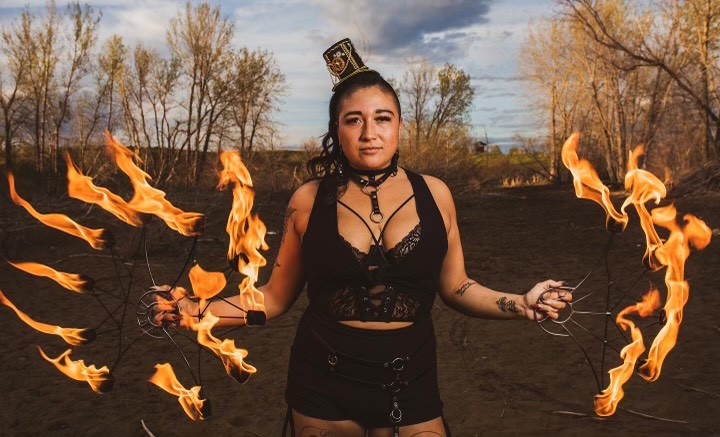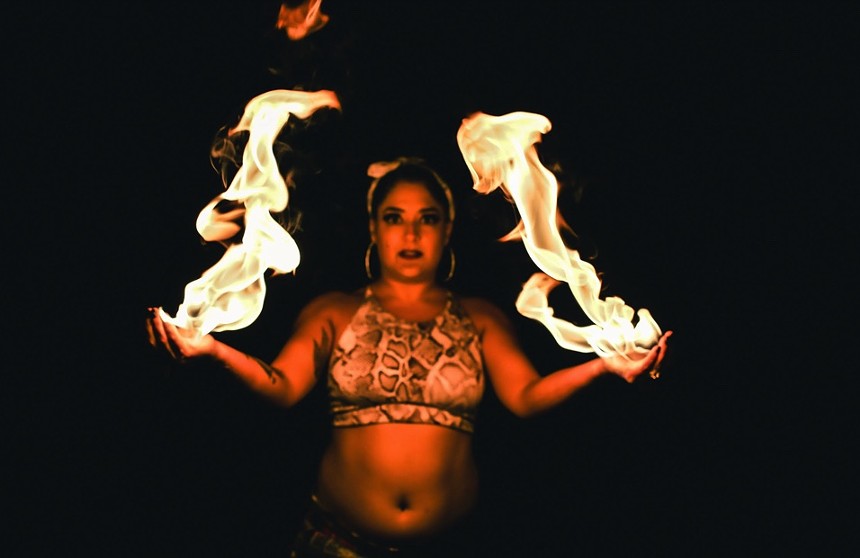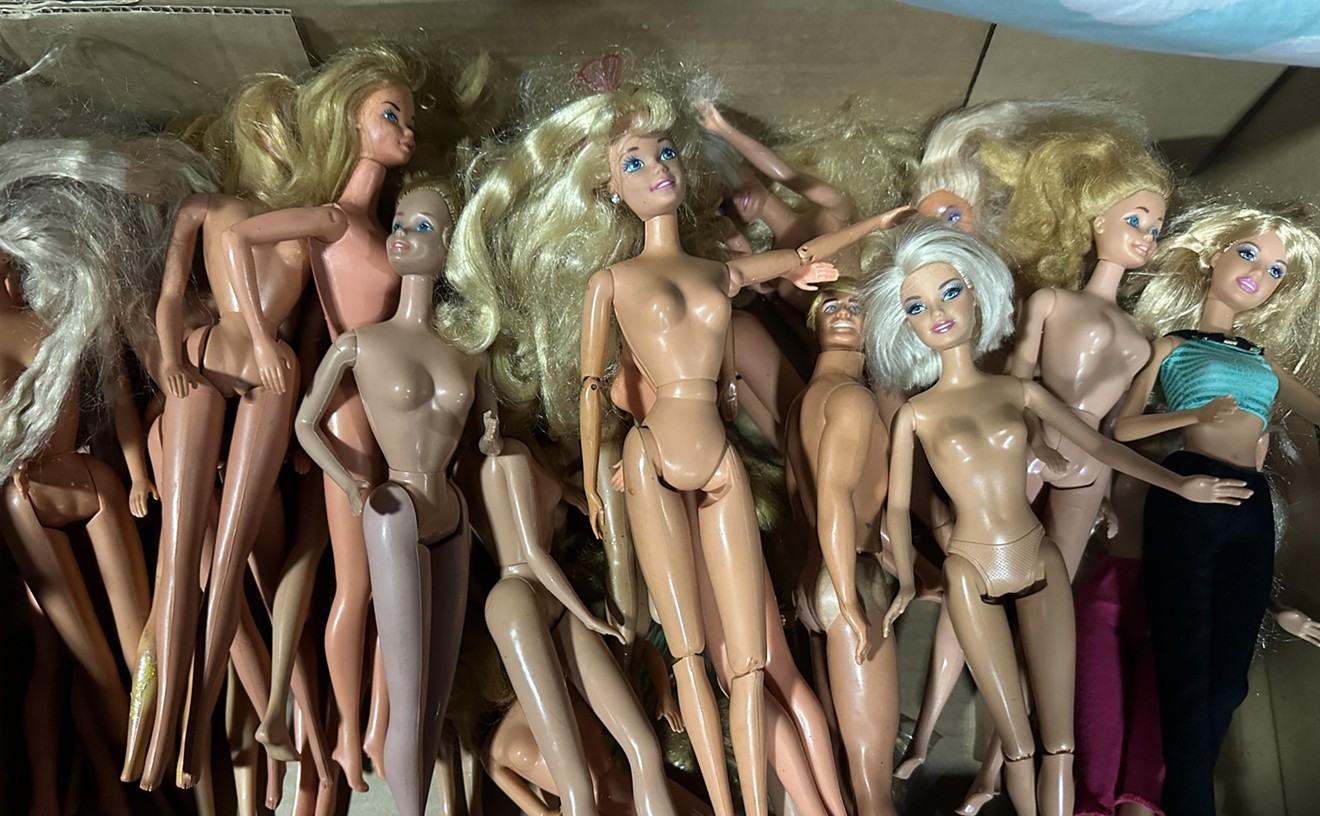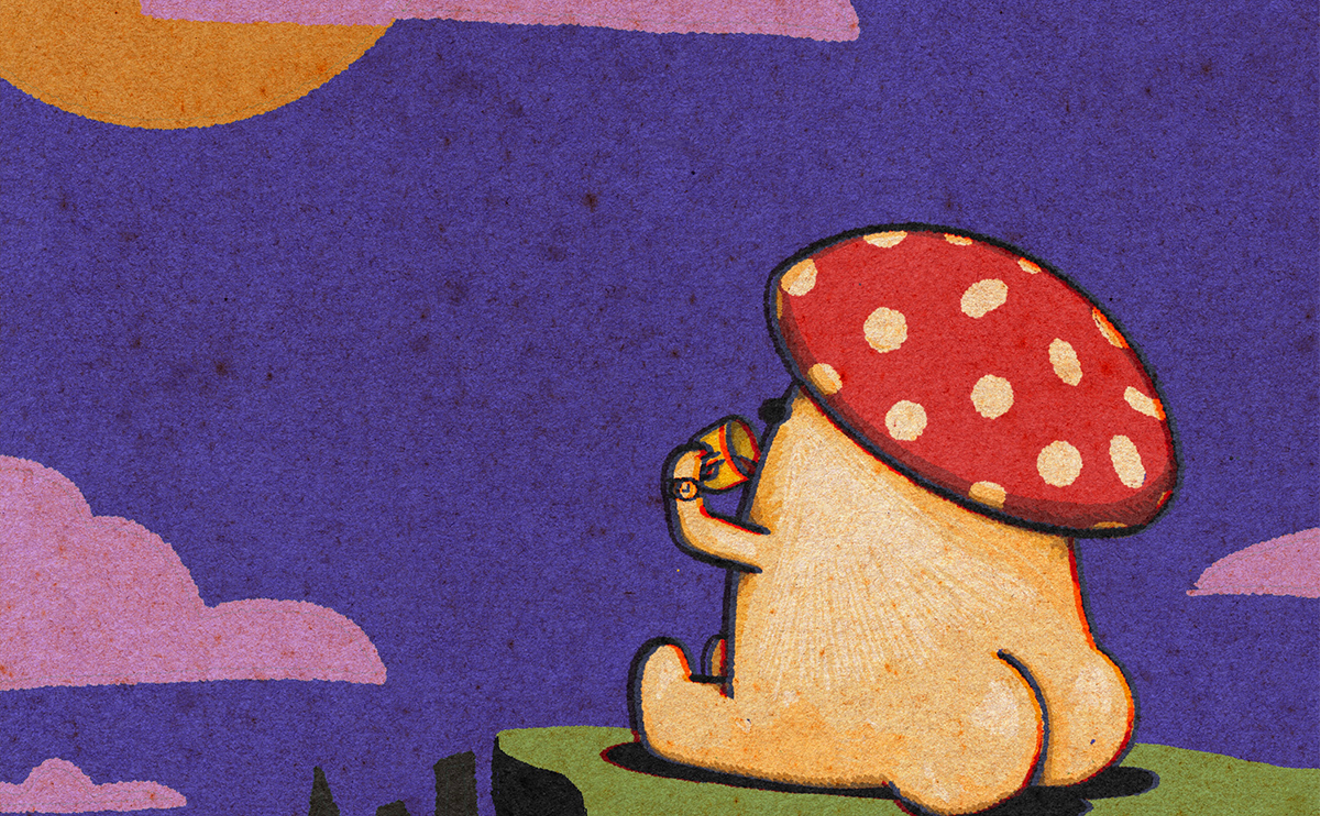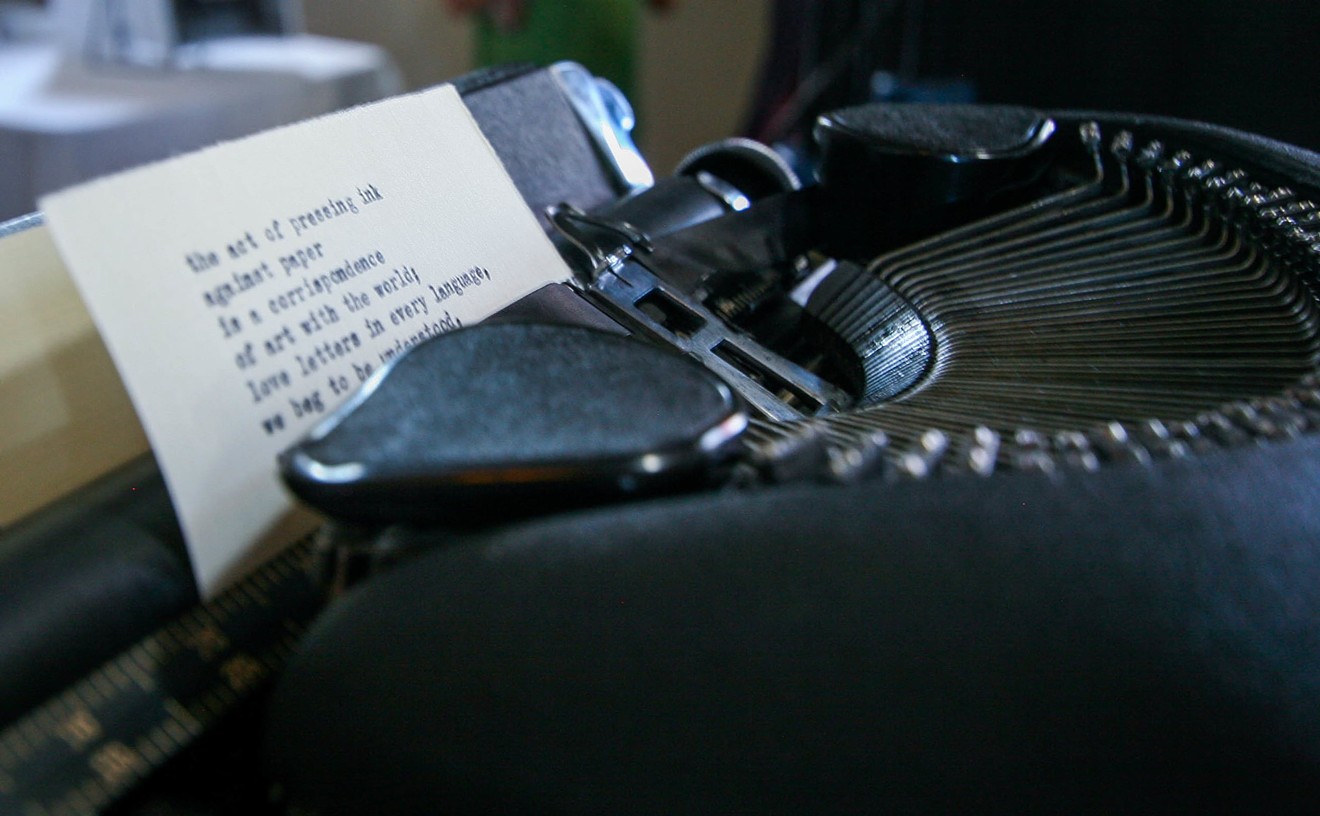This isn't a bizarre commune that's mysteriously materialized. The unofficial “spin jam,” as flow artists call such gatherings, is one of many that happen regularly around Denver, where a large community of flow artists has been migrating for years, drawn by the city’s freewheeling spirit. Meanwhile, the art form itself has grown from a niche, underground activity to a genre that now toes the mainstream line.
“Denver is kind of the central hub of flow arts, honestly,” says flow arts teacher Taelor Brody. “I think it’s just been word of mouth that there are other flow artists here. We all go to the same events together, so we know each other from outside of Denver, people from all over the country.”
Some flow artists are hobbyists, while others have made full-time careers of it. But all are motivated by a healing spirit created by the movement-based art. Brody, who was a part of flow communities up and down the Southeast before settling in Denver in 2016, says that people pursue the flow arts because of the emotional release provided by “movement medicine.” She’s made a name for herself by introducing new movements with her favorite prop, fans.
“I used my dance background heavily in flow arts, and using the state of flow — really losing yourself and releasing yourself in the movement,” she explains. "I would consider flow arts that combination [of dance and flow], but with a prop in your hand. Aside from the movement-medicine aspect of it, you can get really technical with it as well, and involve geometry and the science behind spinning. I try to describe flow arts as a mix between those two things — something that can be really challenging for you and can help you learn something new, but also something that can be used as a release once you enter the flow state.”
The “flow state,” a term coined by psychologist Mihaly Csikszentmihalyi in his 1990 work Flow: The Psychology of Optimal Experience, is what these artists aim to achieve. Csikszentmihalyi postulates that the practice of finding this state of mind — through focusing on a singular action until it becomes blithely autonomous — generates true happiness, creativity and productivity.
“It helps people learn to love themselves again,” says Brody. "To be able to move without any restrictions, really. When people can find that and are able to release anything they go through — trauma, emotions, anger or anything like that — I think that's really healing for people and, in some ways, a spiritual kind of healing. They're really finding themselves again. Honestly, I run to flow arts when I'm in distress or I need some sort of release. It’s very calming and healing, just to be able to move your body freely in a way — and then adding a prop to it is cool, like an extension of yourself.”
As flow artists expand their skill sets, they gravitate to communities and events that champion the art form, including Burning Man and its regional burns. Many flow artists are burners, who migrate from around the world to the Burning Man playa with near-religious dedication every year. Since its beginning in 1986, the "Big Burn" has become a mecca for flow artists — fire spinners, in particular — that allows ample space for free expression.
In the vast desert of Nevada that gives way to Black Rock City, almost anything goes: Fire spinners have renegade burns across the playa; art cars — or mutant mobiles — zip around blasting music from live DJs; yoga classes and healing sound baths pop up out of nowhere; people visit the notorious orgy dome. And, of course, multiple artful objects go up in flames — most notably the Man.
The ideals burners follow seem almost quixotic outside the bubble that vanishes every summer. You'd never know that Black Rock City had been there, because burners are dedicated to strictly upholding Burning Man’s ten principles: radical inclusion, gifting/acts of service, decommodification, radical self-reliance, radical self-expression, communal effort, civic responsibility, leaving no trace, participation and immediacy.
Those principles are reflected in the regional burns, too, including Apogaea, which will begin on June 9 this year. The festival, which showcases art, dance, flow arts and music, will occupy a property two miles in radius in Valdez, twenty minutes west of Trinidad.
Apogaea was introduced in 2005, after a couple of years of planning by about forty burners. Its predecessor, an event called Geodesika that was as much a burn as it was an encapsulation of Buckminster Fuller's futurist ideals, had dissolved in 2003, and Colorado had a freak-fête void to fill. Apogaea's inaugural architect, Julie Mahoney, who had also been a leader for Geodesika, modeled the event after what she'd learned over years of attending Burning Man, where she would arrive a week early and stay a week later to set up and break down the city.
In a YouTube video about Apogaea's founding, Mahoney emphasizes that the burn is meant to reinforce everyone's creativity: If attendees aren't involved, they're just spectators. That involvement can be as big as creating a giant sculpture at the event or as small as bringing extra food for others. Apogaea uses its ticket sales to cover basic expenses, as well as provide grants for burners showing their art at the event. And everyone working with Apogaea — from managers to staff and performers — labors for free.
Denver native Nathan Klein went to his first Apogaea in 2017. He has been a part of the flow arts community for more than a decade, introduced to it through raves he attended as a teenager. “I ended up connecting with two people who I knew from the clubbing scene and Denver who both went [to Apogaea] regularly, one of whom was down to help educate me on how to be prepared,” he recalls. “I went in with very few expectations, with one friend with me, and I now know somewhere around 100 people who have been to this event.”
Today he is immersed in all things Apogaea, working sixty hours a week on the organizing team as well as leading a camp at the regional burn. "Apogaea is one of two regionally sanctioned burns that works with the Burning Man Network, which spans six continents and has hundreds of events across the world," he explains. "The other one in Colorado is Burnal Equinox, in April. The things that make a burn a burn for me are there has to be a temple — a larger art space for reflection where people can do anything from dance to meditate or scatter ashes — or some sort of large effigy." That's the effigy burned at the end of the event, when conditions allow. Apogaea was unable to burn its effigies at its 2006 and 2012 festivals because of "extreme fire conditions."
Given the state’s delicate ecology and threatening wildfires, Apogaea places many limitations on its grounds. For example, at the final effigy burn, no “ember-producing flames" are allowed (that applies to types of fuel and materials, such as wood, that can spark fire into other areas). Instead, Apogaea uses contained, propane-fueled flame. Fire performers must also use specific types of fuel, keep a fireproof blanket on hand and restrict their burns to one area of the grounds.
But fire isn't the only environmental consideration. Leaving no trace means keeping your eyes peeled for MOOP, or “matter out of place.” Everything brought to the festival must be packed up and taken away — including water. “They recommend three gallons of water per person per day, and everyone should pack out all of their gray water — that we used to clean the dishes or make pasta — so it doesn’t go on the ground, because that becomes an ecological issue,” Klein explains.
Such established rules create a systemic foundation that has enabled burns to stay a creative hub of free expression. Theme camps are an integral creative aspect of burns, and far from your average campout. “Camps are one of the things that really give each burn its labor and gifts,” Klein explains. “Maybe the camp offers food, maybe the camp offers late-night dancing, maybe it offers meditation, maybe it offers workshops. The possibilities for what theme camps do are pretty near endless. They have something that adds to the greater event.”
He won’t say the name of his camp — that would go against the burner code of decommodification — but promises that it will have classes on the basics of flow arts as well as how to be an ally to folks in the community who hail from marginalized backgrounds.
Klein isn't the only one knee-deep in Apogaea planning. Caitlin Morris, leader of the fire-spinning conclave Hot Coco, is not only directing a fire performance during the Apogaea effigy burn, but has spent months working on Hot Coco's Burning Man show. It’s the group's twentieth anniversary this year — and her fifth year as leader — so she wants to do it big.
Morris was introduced to spinning fire through friends when she lived in Dillon, and she continued to pursue it when she moved to Denver in 2010 for the "thriving music and art scene," she says. "We have a really beautiful festival culture, and tons of events that support performance artists.”
In Denver, she met other spinners through a regular fire jam during the First Friday Art Walk on Santa Fe Drive (that jam was ended years ago, after crowd control became an issue). “I met a bunch of people in the flow arts community through that, that one chance meeting,” she says. From there, she went on to other public flow jams and learned about Hot Coco, which is the Denver Burning Man conclave group and has about fifty members.
She joined Hot Coco and went to her first Burning Man in 2013, then became assistant shin in 2015 and shin the following year. “As the shin, you’re the point of contact between the group and Burning Man,” Morris explains. “I kind of take on all the leadership roles: I am the director, I am the cat-herder, I’m also the organizer of everything we need to do to submit an audition video, and all the paperwork and things like that. But overall, I have a directorial role. I also am in charge of choosing our safety team, our choreography leads; I usually have five or six different choreography leads. Sometimes I’ll be a choreography lead, but in the past few years we’ve had such amazing talent, including Taelor Brody...I’ve stepped back from writing and just directed.”
2019 Hot CoCo Burning Man Conclave Submission from PIXEL.FLAME on Vimeo.
Flow arts is her passion, and close to her career. “My background is in digital marketing and customer service,” Morris says. “I did this for many years for a local LED prop company called Astral Hoops. I left that company to pursue art and perform, but I do some side work now in property management and turn over Airbnbs. I took this job to have the flexibility to perform and tour with art.”She does solo fire performances for events, weddings and festivals, and will be performing at Sonic Bloom this summer. “I’ve also been training for the last two years with a belly-dance fusion company called Darshan Dance Company,” she notes. “That’s helped push my skill quite a bit as a performer, to have a more solid dance background; it really influences our flow performance. That’s something we can overlook a bit; we focus on tech and all that kind of stuff. So that’s been my focus in Hot Coco, is having that dance element.”
Flow artists often gush over how the art form has led them into more creative expression. Burns and flow arts have given Morris the opportunity to explore other facets of fire art; she’s helped create Gamma Space, a collective that showcases fire sculptures she makes alongside other artists. “What’s different about the Colorado regional is that we are not able to produce or to do sculptures or effigies with ember-producing fire,” she explains. “We’ve had to get creative and do fire art and metal art with propane flame effects instead of burning an effigy. So for the last couple of years, I’ve really focused on fire art. I built the effigy in 2019; it was a piece called 'Draco’s Nest.'”
She’s currently working with a team of artists to create seven fire sculptures for a sculpture garden at next year’s Burning Man. It's a lot of work, she says, but all worthwhile. Burns provide “a platform for anybody to be an artist,” Morris explains. “It really invites anyone, and almost requires anyone who participates in the event to share their artistry. ... Whatever somebody feels is their truest creative expression, Burning Man invites that.”
While burners are passionate folks, no flow artists are more serious about their craft than the ones who enter circus performance, such as Stephanie Marie Little Thunder Morphet-Tepp — or the Flying Brain — who's lived in Colorado for thirty years.
A cheerleader and gymnast through high school and undergrad, Morphet-Tepp discovered flow arts after a car accident in 2012 forced her into physical therapy for three years. “Once I was kind of able to move again, I wanted to get back into movement athletics like I did with gymnastics and cheerleading,” she says. “But, of course, with gymnastics, once you get curves, you’re too old for it, and with cheerleading, once you graduate college, you’re too old for it. So I was fortunate enough to find an aerial class.”
Aerial, which involves being suspended in the air with silks to create shapes through intentional movements, is one of the flow arts genres that crosses into the circus realm. “Some of the most traditional and oldest circus acts are flow arts, like juggling and hoops. However, ‘flow arts,’ to me, encompasses a broader community than strictly circus,” Morphet-Tepp explains. “Flow arts includes hobbyists, people jamming with a prop for fun in their backyard, and people with poi or a hula hoop at a music festival. If you ask the really traditional circus folks, they'll say flow arts was birthed out of circus by the gazoonies — townspeople not born into the circus, but who joined the circus — who learned circus skills on the road and shared these skills with their friends and family when they returned. While there is a bifurcation between circus and flow arts, the two are undeniably related in history and form.”
While she was studying aerial, Morphet-Tepp was also working on her Ph.D. in cellular and molecular biology of infectious disease. “I would go work in the lab all day and go train circus stuff at night just to stay sane,” she says.
After she earned her Ph.D., she worked as a lead scientist for a biotech startup. But she says she quickly learned that she didn’t agree with the “ethics” there (she compares her boss to disgraced Theranos founder Elizabeth Holmes) and told the National Institutes of Health that the company made up data. “What they don’t tell you," she says, "is that being a whistleblower will end your career."
But even as that career ended, it gave Morphet-Tepp her performance name: the Flying Brain. “Fortunately, I had been training circus every day in grad school, so when I suddenly needed a career, I had one,” she says. “I became a full-time performer three years ago, and in that time I’ve done a couple TV shows, I’m working on a world record, I’ve performed internationally.... I’m still flabbergasted at how fast my career has taken off and how fast I’ve developed as an artist.”
Her first performance was six years ago at a student showcase, and since then she has performed with numerous circuses nationally and internationally. She was sought out by the Go Big Show, which aired in January, and she’s currently working with the Bindlestiff Family Cirkus to create an all-Indigenous show in New York City in the fall. While she doesn’t perform much in Colorado anymore — “The rates are pretty low here,” she remarks — she'll teach classes on top of training six days a week before jetting off to perform for a few weeks to make her income. And she's in demand: Today, Morphet-Tepp is one of the only professional hair hangers in North America.
She'd been an aerialist for a couple of years when she saw a hair-hang performance — during which artists hang by their hair while executing various movements — at Cirque du Soleil. “I’m Native American. In my tribe, you don’t cut your hair unless you’re in mourning or going off to battle, so my entire life I’ve had hair down to my knees. It’s really sacred,” she says. "I’ve had super-healthy hair my whole life, and when I saw hair hang, I was like, ‘That’s my act — that’s for me! That’s why I’ve had this hair for thirty years!’”
She spent two years trying to find someone to teach her the skills, but hair hangers don't share as much as other flow artists. “Professional hair hangers — we don’t teach,” she explains. “It’s a family act. As someone who’s lucky enough to know it, the only person who would be appropriate for me to teach is someone in my family. It’s like a closely held family secret.
“I messaged every professional hair hanger in the world — there were maybe a thousand at the time,” she continues. “And no one was willing to teach me, of course. But word got out that there was a girl in Colorado who was desperate to learn hair hanging, and it just so happened that my first tour with Garden Brothers Circus, there was a hair-hang trio. One of the girls was seventeen and ran off with a boy to Europe, so in desperation, they agreed to teach me how to hair-hang. That’s how I learned — in a stinky barn in no-man’s-land Texas. And I trained for a few days and then was just in the show, which is really bizarre. I didn’t realize until later that a lot of people who learn how to hair-hang put weights in their hair for a year or more before their neck has the strength to hold themselves. So I’m kind of a freak of nature.”
Out of all female hair hangers in the world, she can hold the most weight. “Something that I love about circus is you wouldn’t think any of these things are possible,” she says. “I hold over 300 pounds with my hair."
She recalls how at one event, a drunk man was joking about whether she could lift him in the air. To his surprise, she did. And at a recent performance in Costa Rica, she hung by her hair while holding the rest of her body in a lotus posture, engaging her muscles to be completely still for fifteen minutes while fire spinners danced below her.
“When I’m up in the air, it feels like home,” she says. “I never feel more myself than when I’m hanging by my hair in the air. There’s something euphoric, and it feels like something I’m supposed to be doing.”
Her work in circus has shown her that she can achieve what she couldn't imagine, Morphet-Tepp says. She has an aerial student with a physical disability who was turned away by other coaches because they said the student wouldn’t be able to grip a hoop. Morphet-Tepp took her on, and they figured out a way to make it work in spite of the student's disability.
“Anyone can absolutely do these things; you just have to find a way to make it fit your body,” she says. “Magic still exists. You can still find magic in life. What I would tell people who want to get into it [is] just do it. People say they’re too old or too fat or not strong enough or not flexible. And I’m like, ‘Nah, just do it.’ Most circus acts — anyone can do them if you put the work in.”
Work, and thought. Flow artists still face a reckoning regarding where their art comes from and appropriate representation. Hooping, for example, stems from a form of sacred Indigenous dance, as does poi.
“Predominantly, I do traditional circus hooping,” Morphet-Tepp says. “And then there is Indigenous-style hooping. It bothers me quite a bit when people call it geometric hooping; there’s a lot of appropriation there. I think it’s important to respect the culture. With Indigenous cultures, there’s more issues with appropriation and dehumanization than with other minorities. I just had my high school mascot changed from a racist mascot of Indigenous folks in the last year or two. … I talk to hoopers and they don’t even know that it’s a Native thing. Recognizing where it came from and understanding that it’s a storytelling method and a sacred dance — I think that’s important."
That's one of the reasons she's elated about doing an all-Native show with the Bindlestiff Cirkus.
“We wanted to link in as many local Native organizations as possible,” she says, “because it wouldn’t be right to just have Stephanie Little Thunder Morphet-Tepp’s opinion — I’m not an elder. I’ve worked on rezes, but I didn’t grow up on the rez. I’m just one person; I’m not the voice for all Indigenous culture. So if we raise as many Native people together to create a cultural celebration that also educates people of other races, then we’re doing it right.”
Morphet-Tepp has used her art to showcase her Shawnee heritage. “I get asked this a lot, even by other Native artists: How much of my culture can I put in my performance without being sacrilegious?” she says. “Because I’ve done some Native hooping at a burlesque show, or I did a hair-hang number to a Supaman song that was influenced by Native dance. So what I tell people is, 'Think about the things you want to use. Are they sacred?' If I wore my jingle dress to dance at a burlesque festival, that would be so not okay. But a ribbon skirt is different — it’s Native fashion. That’s a way to represent your culture without pushing the line into something that’s sacred and inappropriate. If I wore a headdress, that would be wildly inappropriate, because headdresses are given to you by elders when you did something to deserve it. I can’t just buy a headdress on Amazon or make one on my own.
“We should be sharing my culture. I love putting elements of my culture in my performance, because I’ve gotten people who are like, ‘Wait, there are still Indians?’ And I’m like, ‘Yeah, we don’t look like severed heads of the mascots.’ Because that’s what you see, is this old, stereotypical image,” she says. “So I think it’s important to show people that Natives are still here.”
Straddling circus and flow arts is Candela Collective, a troupe formed in 2017 by Tani Korb, Zoe Kouremenos and Drea Adair. The collective specializes in aerial as well as fire performance, and as often happens with flow arts, it came together through chance.
“I was living in California, and I came out to visit and fell in love with Colorado,” Korb says. “I met Zoe, who I noticed was an incredible aerialist, and just dedicated. So we decided to form Candela after I moved here in 2017, and we were so lucky to find Drea, the fastest learner in the West.”
“We really came up with our name going through different definitions of things,” Kouremenos adds. “Candela means a unit of luminous intensity in science, and we were like, what a perfect thing to call ourselves! We each offer something unique to the collective. Tani is super-skilled at hoops and teaches us all of our hoops stuff; Andrea is really good at media and videography and photography and helps us with that; and then I bring in the aerial aspect and choreograph our aerial gigs and train the girls on that stuff. It was really nice to find this collective that you could consistently rely on for that practice.”
The trio also brings in “honorary members” to diversify the content of its acts. Candela showcases how flow arts is not just a singular activity, but one that necessitates involvement with community and pushing yourself out of your comfort zone. The collective's members motivate each other and hone each other's skills. “It’s kind of funny the way the metaphor is: We’re holding each other up physically on the silks and doing all these different things, but we’re also holding each other up emotionally, and we were able to create this sisterhood together,” Korb says. “There was an instant connection for all of us — it’s unlike any other relationship you have when you’re in a troupe with people.”
“Our most unique quality is that we’re one of the few collectives that do triple silks,” adds Kouremenos. “It’s not really a big thing yet, so we’ve been going in and designing things that haven’t been done yet, and it’s been really fun for us. That’s our unique little edge.”
“We try to create new shapes, and Zoe’s always coming up with things that look impossible,” Korb says, laughing. “And then we kind of just play around with it. That’s what we pride ourselves on.”
Kouremenos says the flow arts community has helped her make friends as far away as Thailand, while Korb has gone to flow festivals in Cambodia. “It’s really encouraging, because people are happy to show you and share with you, which is something I hadn’t really experienced — that open willingness to just give,” she says.
“It’s an incredible way to instantly find community,” adds Adair. “If you’re flowing and someone else is, you can instantly start a conversation and start learning from each other. The first time I went to Cheesman Park, I had so many new friends.”
Flow arts brings out the curious. “I have people come up to me at shows or corporate events who have never seen things like this, who say they could never do it because they’re uncoordinated,” says Korb. “And I’m like, ‘I am a klutz, I am so clumsy.’ It’s a different kind of thing, though, when you pick up a prop and can surprise yourself. When you pick up a prop, you can tell if it will be your thing, and if not, try another one. Go to a flow jam, and anyone will be willing to teach you. People love involving other people in it and being able to show them things. We were all beginners once; no one starts at an advanced level.”
“It’s a beautiful gift to suck at something,” Kouremenos adds, “because one day, you’re going to look back at that and see your progress. A beautiful thing I’ve gotten from the flow community is a bunch of people who are willing to help you to figure out how to express yourself and find your own equanimity in whatever you’re doing.”
These days, one of the ways people can express themselves is through online tutorials and performances.
Nathan Klein has been involved with flow arts for a long time, and has seen rapid advancement because of social media over the past decade. “There were a handful of kids at my high school who regularly went to raves and would use light gloves and glow sticks,” he recalls. “I learned three moves that I could do with glow-stringing, or poi. Because of that, I've technically been spinning poi for over a decade, but for the first almost ten years of that, up until like 2017, I only knew the three moves. And there’s definitely hundreds, if not thousands, if not millions — depending on how you count variants — more. I tried to catalogue what I know now, and it’s somewhere around 400, at least.”
Such moves and variations have been documented by serious flow artists, who carefully dissect their craft. Graphs and charts containing the thousands of moves include the Vulcan Tech Gospel, which exemplifies just how inexhaustible flow arts has become.
“You can study that, master that, and that will definitely make you a very beautiful, technical flow artist,” Morris says, “but it may not have the same impact as somebody who incorporates dance, who moves around space, incorporates footwork and interactions among other performers.”
Taelor Brody has used sources such as VTG while also tapping into her dance background to create a seamless combination between buttery flow and mesmerizing, mind-boggling moves. Her work has made her the equivalent of an influencer in the flow arts realm. “She truly is a master of marrying tech and flow,” Morris says of Brody.
Brody began her journey with flow arts in 2013, when she started to perform at music festivals. “I honestly wanted to do it for my ego, to be completely frank,” she admits. “But I was like, 'Wow, this is so cool. I want to be a cool person.’ And then, you know, after performing for a few years, I also feel like I got to see the not-so-cool side of performing.”
Brody found that flow artists aren’t immune to the rapacious desire for recognition in which artists working in any genre can lose themselves — and she didn’t want to get to that level. She also discovered that while music festivals would promise payment, often “something would magically fall through and we wouldn’t be paid," she says.
Disillusioned by music festivals, she stuck to corporate and private events. And then she began to perform at flow festivals, where she would also teach workshops. Now she says she's fine with coaching and spinning fans for her own pleasure. “It was just really nice to share that connection with someone and be able to teach someone something that they've really been wanting to know,” she says. “And maybe this one tip that I had was able to help them.”
She helped them through social media, too, where her Instagram page amassed thousands of followers. “I love to talk about social media, and specifically with flow arts, just because I feel like there's so much to it,” she says. “Honestly, I used to only post on social media for myself, to keep a visual journal so I can watch my own progress. But then flow arts started to blow up; more people started posting their videos and their photos on Instagram pertaining to flow arts. It was just popping up everywhere.”
As flow arts became popular, so did Brody’s videos. “When that started happening, I was like, ‘Oh, well, I'm kind of getting some attention from this. Maybe I should post more, because people want to see these things, and they're really singing my praises.’ And it was helping motivate me to learn and keep going, and so I'm kind of thankful for that. It's helped me get a lot of jobs, it's helped me just meet a bunch of people, and it’s — to put it simply — helped me be well-known.
“I used to really, really, really, really enjoy that,” she continues. “It really stroked my ego, not gonna lie. But then I feel like I had to really go and humble myself because — same thing as when I tried to make flow arts a living — I feel like I was losing my passion for my personal practice, because I was just so focused on creating videos for the internet that I wasn't really doing it for myself.”
After giving herself some time away from social media, she began to recognize why she enjoyed flow arts in the first place.
“It’s being able to challenge myself. I really like to go to battle with myself,” she says, and laughs. “I tried to do the most difficult things, and I'm also a very stubborn person, so with getting into flow arts, it's been humbling to fail repeatedly. I don't want someone else to push me, because then I feel like I'm doing it for them. But if I can push myself and challenge myself…that’s what really motivates me through flow arts. No matter that I've been in it for almost ten years. It's really nice to still be able to learn.”
Social media is a place where new flow artists can learn, Klein says, from videos that cover basic to advanced moves. He started spinning poi well before there was a plethora of YouTube tutorials, however.
“Social media and flow arts is interesting,” he says. “This is where the generation I’m from will start showing, because I don't use Instagram, I don't use Snapchat, I don't use TikTok, I don't really use Twitter. I use Facebook because it outgrew MySpace. Social media can be great for sharing knowledge, which I really like. I'm in somewhere around thirty to sixty groups on Facebook. It can be good for sharing knowledge of equipment, of technique, of style.”
While Facebook is great for communicating with other flow artists and finding local spin jams — there are at least seven groups in metro Denver — Klein notes that “there’s also great potential for people to just use it to platform themselves, to inflate their egos, to build their brand in a manner that doesn't serve their community. And I'm not saying that the people who are making props or performers who are building a brand are in any way not part of what should be happening. But the manner that a lot of people use ego in order to put social dominance over other people is not great.”
Most flow artists are open to learning not just moves, but the history behind their passion of performing with a prop.
“We go through a lot of challenges; I’m pre-med, so I have a lot going on,” says Candela Collective’s Kouremenos. “[Flow arts] gives you a place to go and express yourself in a way you cannot in the day-to-day. The emotion and total let-go you can have in the air or doing hoops or whatever, it’s like you can just truly express yourself and be free for a moment. ... That’s the biggest thing for me, is having that safe place for that, and then allowing others to come in and have that safe place, too.”
The pavilion at Cheesman Park is such a safe place, both for the performers finding childlike joy in working with what seem like toys to the spectators who experience a refreshing sense of community and simply can't look away from the spin jam.
“It’s really a little pocket of magic left in the world, and it’s something I feel good about doing,” says Morphet-Tepp. “No, it’s not developing anti-virals or curing diseases, but I think it’s special that I’ve found something that’s still an authentic source of magic in the world.”
Apogaea runs June 9-11; find more information at apogaea.com. Follow Taelor Brody on Instagram @taelorgang_; follow Caitlin Morris on Instagram @comusicnerd; follow Hot Coco on Instagram @hotcoco_fire; follow Stephanie Morphet-Tepp on Instagram @theflyingbrain; follow Candela Collective on Instagram @candela.collective or on its website, candelacollective.com.


